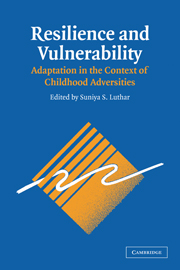Book contents
- Frontmatter
- Contents
- List of Contributors
- Foreword by Dante Cicchetti
- Preface
- 1 A Resilience Framework for Research, Policy, and Practice
- PART I FAMILIAL ADVERSITIES: PARENTAL PSYCHOPATHOLOGY AND FAMILY PROCESSES
- PART II EXOSYSTEMIC AND SOCIODEMOGRAPHIC RISKS
- 10 Rethinking Resilience: A Developmental Process Perspective
- 11 Poverty and Early Childhood Adjustment
- 12 Emerging Perspectives on Context Specificity of Children's Adaptation and Resilience: Evidence from a Decade of Research with Urban Children in Adversity
- 13 Holistic Contextual Perspectives on Risk, Protection, and Competence among Low-Income Urban Adolescents
- 14 Overcoming the Odds? Adolescent Development in the Context of Urban Poverty
- 15 Adaptation among Youth Facing Multiple Risks: Prospective Research Findings
- 16 Positive Adaptation among Youth Exposed to Community Violence
- 17 Perceived Discrimination and Resilience
- 18 Promoting Resilience through Early Childhood Intervention
- PART III COMMENTARIES
- Index
- References
11 - Poverty and Early Childhood Adjustment
Published online by Cambridge University Press: 05 June 2012
- Frontmatter
- Contents
- List of Contributors
- Foreword by Dante Cicchetti
- Preface
- 1 A Resilience Framework for Research, Policy, and Practice
- PART I FAMILIAL ADVERSITIES: PARENTAL PSYCHOPATHOLOGY AND FAMILY PROCESSES
- PART II EXOSYSTEMIC AND SOCIODEMOGRAPHIC RISKS
- 10 Rethinking Resilience: A Developmental Process Perspective
- 11 Poverty and Early Childhood Adjustment
- 12 Emerging Perspectives on Context Specificity of Children's Adaptation and Resilience: Evidence from a Decade of Research with Urban Children in Adversity
- 13 Holistic Contextual Perspectives on Risk, Protection, and Competence among Low-Income Urban Adolescents
- 14 Overcoming the Odds? Adolescent Development in the Context of Urban Poverty
- 15 Adaptation among Youth Facing Multiple Risks: Prospective Research Findings
- 16 Positive Adaptation among Youth Exposed to Community Violence
- 17 Perceived Discrimination and Resilience
- 18 Promoting Resilience through Early Childhood Intervention
- PART III COMMENTARIES
- Index
- References
Summary
Childhood poverty appears to be an enduring and entrenched problem, resistant to most social and economic policies intended to lift families above the poverty line. Although rates of poverty among families of pre–school-age children initially declined during the 1960s, when antipoverty programs directed at children and families were initiated, rates rose throughout the 1970s and 1980s and leveled off in the 1990s, with the consequence that young children continue to experience poverty at alarmingly high rates. In fact, in 1999 about one in five infants and preschool-age children in the United States lived in families whose incomes fell below the poverty threshold (U.S. Census Bureau, 2000a). Poverty is considered a pervasive and nonspecific stressor, rather than a bounded one, because it negatively affects many aspects of individual and family functioning; yet at the same time, many impoverished children are positively adjusted (Garmezy, 1991; Luthar, 1999; Werner & Smith, 1992). How is it that some children are vulnerable to the effects of poverty, whereas others demonstrate positive adjustment (i.e., resilience)? Attempts to answer this question are at the core of this chapter. Our primary objective is twofold: to summarize findings from relevant literatures regarding factors associated with better or worse adjustment among young impoverished children, and to showcase one effort toward the identification of such factors using data from the Pitt Mother and Child Project, a longitudinal study of adjustment and psychopathology among young boys from low-income families.
- Type
- Chapter
- Information
- Resilience and VulnerabilityAdaptation in the Context of Childhood Adversities, pp. 267 - 292Publisher: Cambridge University PressPrint publication year: 2003
References
- 19
- Cited by



